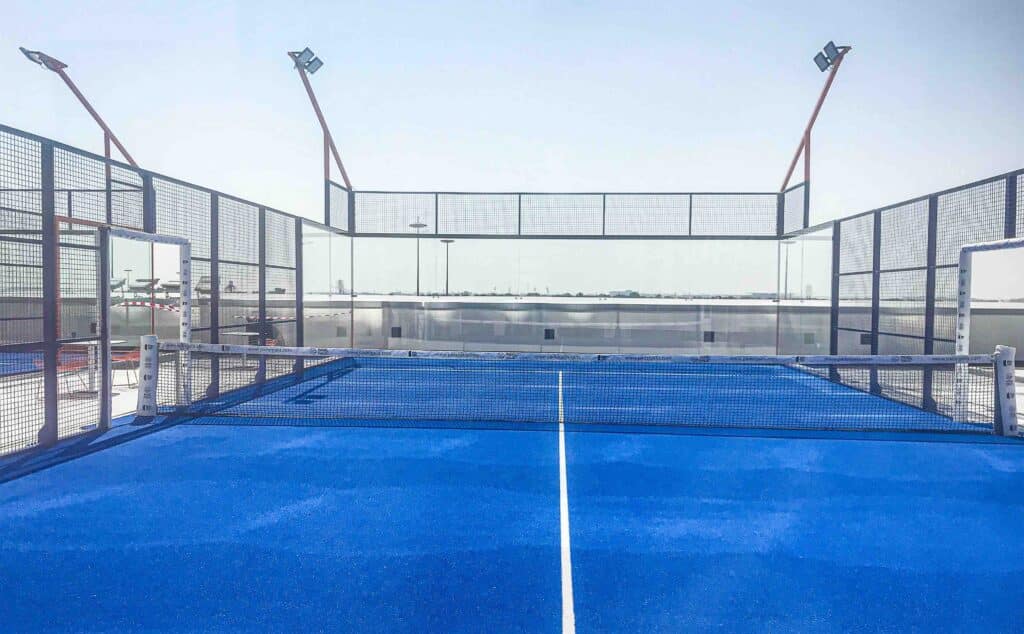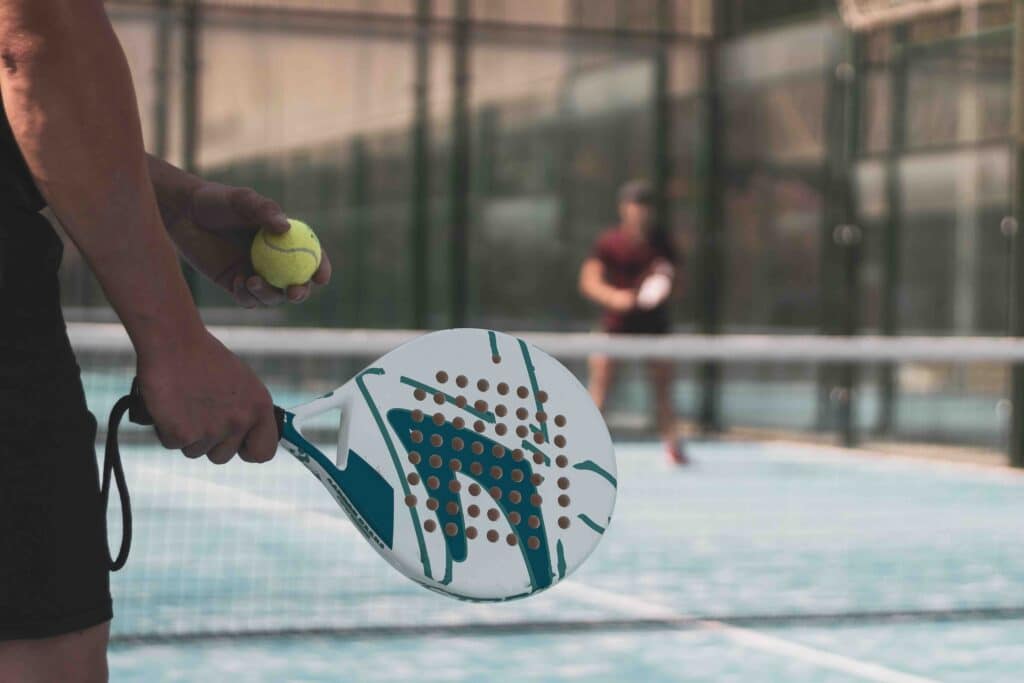What’s the Difference Between Padel and Pickleball?
| May 6, 2024

Pickleball and padel are both paddle sports and are very similar to each other, but there are several important differences when it comes to court size, game play, equipment and more.
Check out some of the similarities and differences here.
Layout and court size
The pickleball court is 44 feet long by 20 feet wide. There’s a non-volley zone for pickleball seven feet from the net on both sides of the court. The net in pickleball is 36 inches high on the ends and 34 inches high across the middle section of the net.
Standard-sized padel courts are measured in meters, so the measurements aren’t a round number when designated in feet. Rounding up slightly, padel courts are 66 feet in length (20 meters) and 33 feet in width (10 meters). The padel net height is very similar to that of pickleball, with the net measuring 36 inches on the ends and 35 inches in the center (again, these numbers rounded up and down respectively to account for padel using centimeters).


Equipment
Padel is played with solid paddles made of composite materials such as carbon fiber or fiberglass, similar to what pickleball paddles are made of. However, padel paddles are much thicker and more powerful, with hard foam centers and perforated holes on the surface. The paddles are heavier than those of pickleball and feature a thin strap that goes around the wrist.
The padel ball is a small, fuzzy, rubber ball that looks like a tennis ball, but is decompressed (has significantly less air inside it).


Pickleball is played with paddles made of wood or composite materials like graphite or carbon fiber. The ball is similar to a wiffle ball, but is a bit heavier. It has holes in it and is usually made out of a composite plastic. There are both “indoor” and “outdoor” balls.
Gameplay
Padel is almost fully inclosed by glass and wire walls, and the ball can be played off of the walls, making it similar to racquetball or squash. Players can take advantage of various angles that aren’t present in pickleball as well as ricochet the ball off of the walls to create advantages and more dynamic points.
Pickleball is known for its strategy, with players engaging in short shots or fast drives near the non-volley zone, favoring placement over power. Power is certainly an element of the game, but in comparison to other racquet sports, like padel, placement and precision are more important than hitting the ball with force.
Like pickleball, padel is nearly always played as a doubles sport, but singles does exist and is played on the same size court, just as pickleball singles is.
Scoring
Padel scoring is the same as tennis scoring. Each game starts with both players at “love” (zero) and is played using the following progressive language for points: 15, 30, 40, game. Therefore, only four points are needed to win a game. Games must be won by a minimum lead of two points, so if both players reach a score of 40, it’s called “deuce,” and players progress to using the terminology “ad in” and “ad out” to designate which player has a one point advantage in the game. The player with the ad (one point past deuce) will either will win the next point and the game or lose the next point and go back to deuce. Games are played in “sets,” which are a compilation of games, with the winner reaching six games first. However, sets must be won by a minimum lead of two games. If players reach 6-6 in games, a tiebreaker to seven points is played to determine who will be the winner of that set. Sets are best two out of three, with the winner taking the match.
Pickleball games are played to 11 and a team must win by at least two points. Matches are usually formatted in a best two-of-three games style. Only the serving team can score points in pickleball, which is called “side-out” or traditional scoring. “Rally scoring” is another way to score games that is occasionally used, but is a much newer method.
Serving
In padel, players have to serve underhand behind the designated service line on the court, starting from the right side (or the “deuce” side). The server must alternate serving from the left and right sides of the court. The serve must be hit into the opposing (diagonal) service box and returners must take the ball off the first bounce.
Servers have two chances to make the serve, which, if they fail to do so, results in a double fault and the loss of a point. Faults occur when the ball lands out of bounds or hits the wall first.
In doubles padel, the serve stays with a single player for the duration of a game. Once the game is finished, the serve rotates to a player on the opposing team, with all four players switching off uniformly between each game.
In pickleball, the underhand serve is very similar. Serves must be diagonal, cross-court, with both feet behind the baseline. The serve must be in an upward motion with the impact coming below the waist. Serves also have to land beyond the non-volley zone or it is a fault. Each server in pickleball gets one attempt.
If the serving team earns a point, the server will switch sides with his or her partner and serve to the opposite side. This continues until the receiving team wins a rally.


How hard is it to play?
Padel may take some time to learn, so don’t expect the same ease into the game like pickleball. The sport requires good hand-eye coordination, excellent footwork and movement, and good paddle control. The ball is a lot harder to control, flies through the air faster, and the court is bigger with more room to cover. Playing the ball off the walls is a skill with a high level of difficulty that takes time to learn.
By most accounts, people seem to have a fairly easy time learning to play pickleball. The rules are simple, and the smaller court and slower ball speed are helpful for new players. Pickleball has a low barrier for entry, unlike tennis, and is described as a mix between a number of racquet sports, making it fairly accessible to people of all ages and different athletic abilities.
How physically fit do you need to be ?
Pickleball still demands good footwork, excellent eye-hand coordination, and quick reflexes, but because the court is smaller and the ball a bit slower, the demands on the body are definitely less than padel, tennis, or squash.
Padel is similar to many other paddle or racquet sports. It’s not a requirement to be physically fit, but it will help your game if you are. Having good cardio endurance, agility, and strength will help sustain your performance level.
How popular is the sport?
Padel is growing at a rapid rate amongst paddle/racquet sports and has a dedicated following in urban areas like New York City, as well as a budding presence in parks and community centers. Courts for padel are less common than tennis, racquetball/squash, or pickleball.
Pickleball courts are more plentiful today than they were a year ago and certainly more than 10 years ago. There are numerous places to play for any skill level player. In addition, there are multiple professional tours, which means more people are watching the sport today than ever before.
Both pickleball and padel have all the social benefits of players being close together, teamwork, and camaraderie. They have differing levels when it comes to ease of learning, but are both increasingly popular and incredibly addicting.






1 comment
Padel seems to be a bit of a growing sport in the Middle East, particularly the United Arab Emirates where I currently live. The cost to play Padel here is somewhat prohibitive, and the courts are used almost exclusively at night. Due to the demographics here, I do not see how Padel can possibly enjoy the surge in popularity as has occurred with Pickleball in other places.